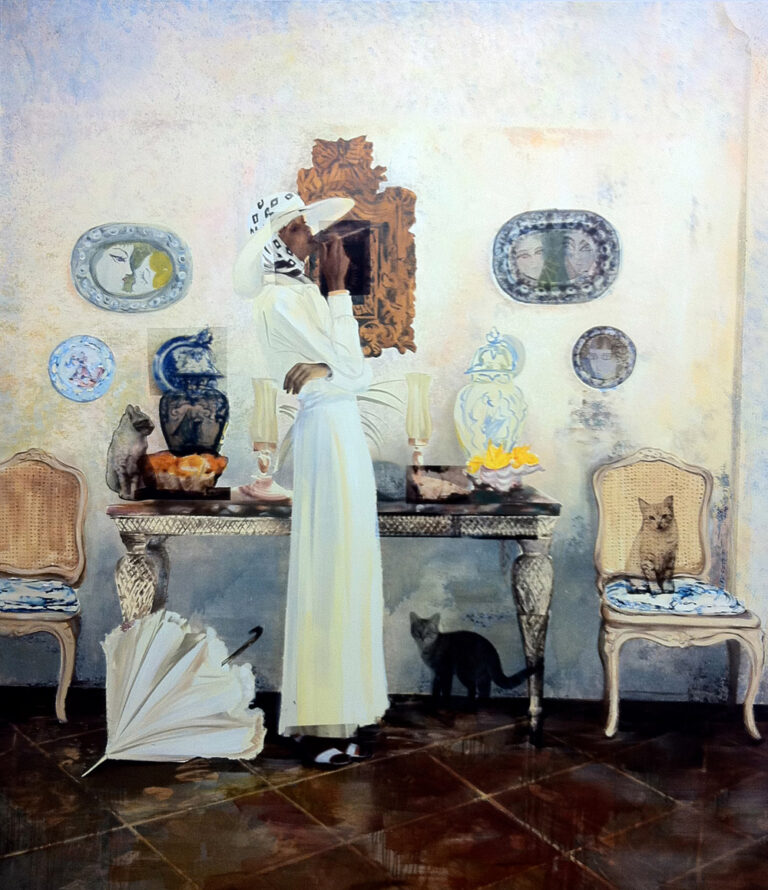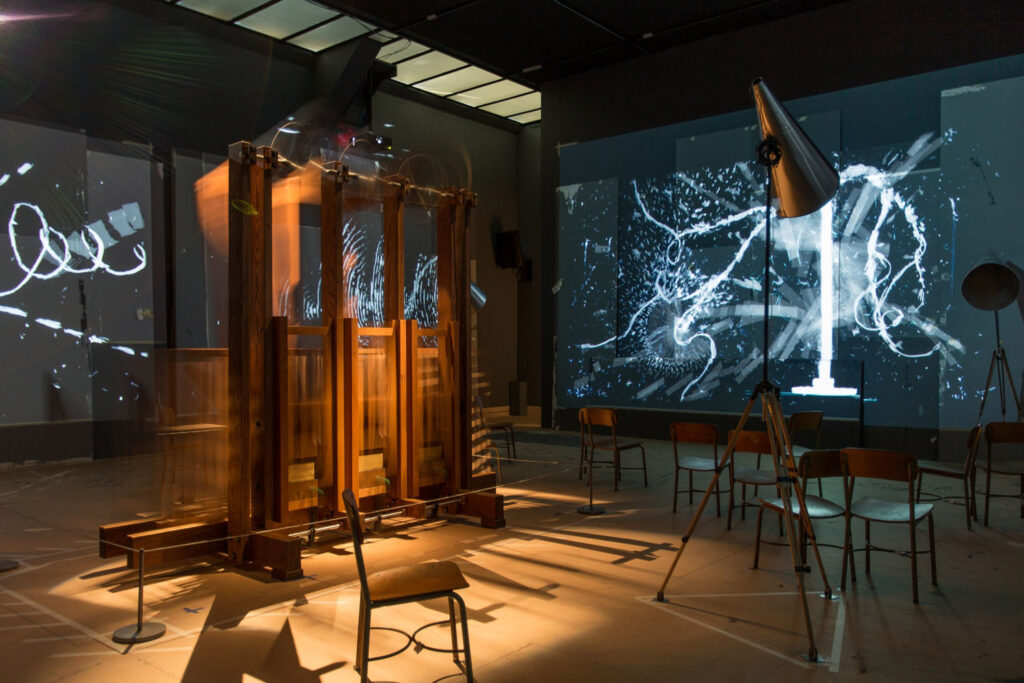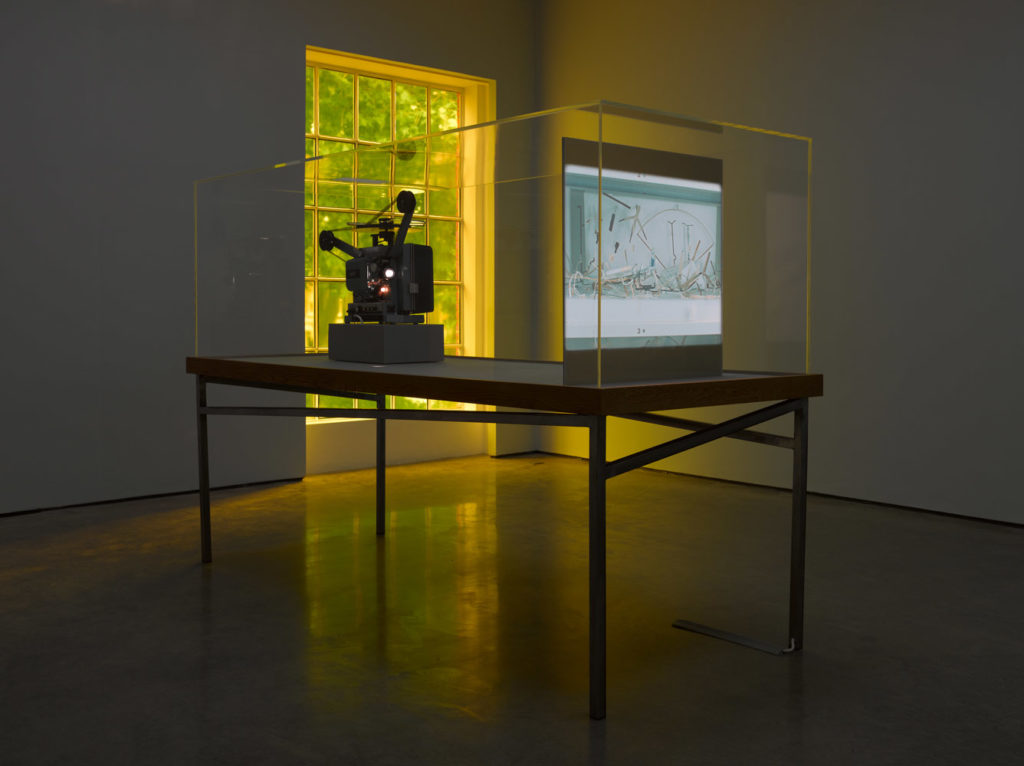
Paulina Olowska, A Portrait of the Artist—Indoors, 2012; oil paint, ink, and transparency on linen; San Francisco Museum of Modern Art, Accessions Committee Fund purchase; © Paulina Olowska; photo Don Ross
SAN FRANCISCO, CA (November 1, 2016) — The San Francisco Museum of Modern Art (SFMOMA) announces the complete reinstallation of its seventh floor with three new contemporary exhibitions — A Slow Succession with Many Interruptions; William Kentridge: The Refusal of Time; and Runa Islam: Verso — on view from December 10, 2016 through April 2, 2017. Underscoring its deep commitment to engaging with living artists, SFMOMA presents in these exhibitions a thought-provoking selection of the art for our time.
“We are excited to share these three exceptional shows, comprising works made over the past 16 years from our permanent collection — many of which have rarely or never been on view to the public previously,” said Neal Benezra, Helen and Charles Schwab Director at SFMOMA. “These presentations emphasize our ongoing support of living artists, which is paramount to our mission.”
A Slow Succession with Many Interruptions
A Slow Succession with Many Interruptions reflects on the ways that artists have responded to the evolving conditions of the 21st century. Composed of work by 40 artists, the exhibition broadly considers the fluidity of ideas and how artworks embody time. The installation, which highlights recent acquisitions and works on view to the public for the first time, calls attention to the varied forms and approaches taken by different artists and the connections between the personal, the intimate and the individual; constructions of identity, history and culture; the instability of materials; and strategies to rediscover or recover the past.
The title phrase is taken from art historian George Kubler’s seminal book The Shape of Time (1962), in which the author proposes a history of “things” — including artworks — that traces connected ideas developed in sequence, sometimes over centuries and with intervening deviations and lapses. Through ideas, artworks are affected by their historical context and, in turn, affect it.
“By considering the complex and often contradictory continuum of the past 16 years, A Slow Succession with Many Interruptions brings together profound meditations on equality, loss, desire, migration, materiality and the everyday,” said Jenny Gheith, exhibition curator and assistant curator of painting and sculpture at SFMOMA. “We see artists creating ambitious installations in non-traditional materials such as sand and grass alongside quiet reflections that mark the passage of time.”
Representing a range of approaches and media — including painting, sculpture, works on paper, photography, film, video and performance — A Slow Succession with Many Interruptions features a dynamic cross-section of contemporary art. Beginning with a performance work by Tino Sehgal in Helen and Charles Schwab Hall and continuing to unfold through a series of seventh-floor galleries organized according to shared formal and conceptual affinities, the exhibition is punctuated by monographic installations by Lutz Bacher, Trisha Donnelly, Dora García and Emily Jacir. Other highlights of the exhibition include works by artists Tauba Auerbach, Tacita Dean, Peter Fischli and David Weiss, Colter Jacobsen, Mark Manders, as well as Sam Lewitt, Paulina Olowska, Catherine Opie, Walid Raad and Danh Vo, among others.
Significant support for A Slow Succession with Many Interruptions is provided by SFMOMA Collectors’ Forum.

William Kentridge, The Refusal of Time, 2012; jointly owned by the San Francisco Museum of Modern Art, and The Metropolitan Museum of Art, New York (purchase, by exchange, through an anonymous gift and the K. Hart Smith Trust); © 2012 William Kentridge, all rights reserved; photo: courtesy The Metropolitan Museum of Art
William Kentridge: The Refusal of Time
Making its West Coast debut at SFMOMA, artist William Kentridge’s The Refusal of Time (2012) is an immersive installation combining synchronized video projections featuring live action, animation and dance, with audio feeds that incorporate music and sound and a central kinetic sculpture called “the elephant,” which breathes a steady rhythm from the center of the gallery. Jointly owned by SFMOMA and The Metropolitan Museum of Art, the work evokes an embodied history of time while simultaneously expanding our ideas about how we mark its passage.
“With this complex and masterful immersive installation we found the perfect match for our long-standing commitment to the artist, which includes significant holdings in the Fisher Collection,” said Rudolf Frieling, exhibition curator and curator of media arts at SFMOMA. “The Refusal of Time embodies the sum of Kentridge’s work, casting a wide net of references from old Europe to the rebellious African South. It synthesizes his strikingly beautiful and hybrid aesthetic with not only a sense of political urgency, but also infectious exuberance.”
Commissioned originally for dOCUMENTA 13 in Kassel, Germany, The Refusal of Time continues where Five Themes, SFMOMA’s major survey of Kentridge overseen by Frieling, left off in 2009. Growing out of conversations between the artist and Harvard University physicist Peter Galison and collaborations with composer Philip Miller and video editor Catherine Meyburgh, it encompasses the artist’s diverse range of artistic practices and visual motifs including drawing, film, sculpture and performance. In the installation, viewers will find energetic combinations of allusions — to Greenwich Mean Time, Einstein’s theory of relativity, the burgeoning Industrial Age of the late 19th century, South African theater — illuminating a world that is constantly revolving and breaking apart, and always profoundly alive.
William Kentridge was born in Johannesburg, South Africa, and attended the University of the Witwatersrand and the Johannesburg Art Foundation, and studied mime and theater at L’École Internationale de Théâtre Jacques Lecoq, Paris. He is widely renowned for his animations, drawings, prints, books, tapestries and sculptures addressing life both during and after apartheid.
Generous support for William Kentridge: The Refusal of Time is provided by Carolyn and Preston Butcher.

Runa Islam, Cabinet of Prototypes, 2009–2010; San Francisco Museum of Modern Art, purchase, by exchange, through a fractional gift of Shirley Ross Davis and the Accessions Committee Fund; © Runa Islam; photo: courtesy White Cube (Ben Westoby)
Runa Islam: Verso
This solo presentation of the Bangladesh-born British artist Runa Islam features the U.S. premiere of Cabinet of Prototypes (2009–10), a 16mm film installation from SFMOMA’s collection that serves as the exhibition’s point of departure for exploring the threshold between film and sculpture. Originally commissioned for the Kivik Art Centre in Österlen, Sweden, as a projected film for an architect’s pavilion set in the sculpture park’s grounds, the work was later reconfigured into a cinematic sculpture by enclosing both the projector and screen within a glass vitrine.
At SFMOMA, Cabinet of Prototypes is brought for the first time into conversation with a second film, Magical Consciousness (2010), both of which stemmed from Islam’s Smithsonian Artist Research Fellowship and her time with the collections at the Freer Gallery of Art and Arthur M. Sackler Gallery in Washington, DC. Cabinet of Prototypes studies the custom-designed armatures used to support and present Asian artifacts; a window into the SFMOMA Conservation Workroom from the gallery creates a conceptual and physical link between display and preservation. Through anamorphic black-and-white 16mm film, Magical Consciousness (2010) transforms the gilded back of a six-panel 16th-century Japanese folding screen into a meditation on the ‘silver screen’ of cinema.
“This exhibition foregrounds Runa Islam’s layered and inventive approaches to working with the physical elements behind the illusion of film,” said Tanya Zimbardo, exhibition curator and assistant curator of media arts at SFMOMA. “In her subject matter, Islam often gravitates to the overlooked or peripheral. Both films also gesture to the labor behind the objects presented.”
A third gallery of new and recent works includes several objects incorporating Islam’s ongoing process of reclaiming the silver from exposed celluloid. Anatomical Studies (2014) casts select items from the artist’s studio in the ‘latent’ silver, including the type of silver pencils employed in her drawing series, …laws of night and honey (2016). Together in Runa Islam: Verso, the selected works investigate material shifts through the lens of institutional collections and the artist’s personal archive.
Born in Dhaka, Bangladesh, Runa Islam lives and works in London. She attended the Royal College of Art, London; the Rijksakademie van Beeldende Kunsten, Amsterdam; and Middlesex University / Manchester Metropolitan University. Islam has been in numerous solo and group exhibitions worldwide since the late 1990s.